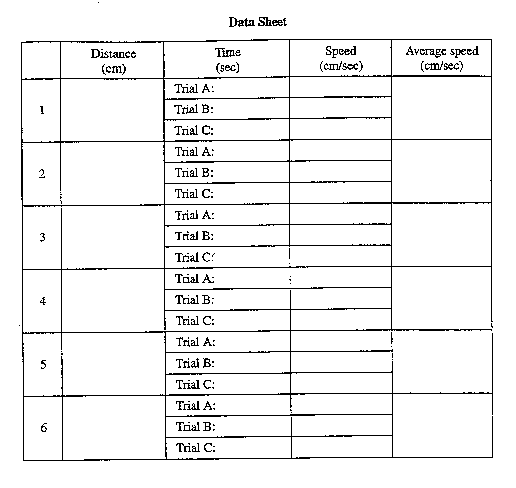Contributed by: Council of Chief State School Officers (CCSSO/SCASS)
TO THE STUDENT
Welcome to this experimental science exercise. We hope that you will
find it interesting and worthwhile. Carefully read through these directions
and the directions on the next page before you begin to work.
You may be part of a group for the first part of this exercise.
Each group should carry out the experiment and collect the data
together, but each student must record the data in his or her own
booklet. Be sure to record the data exactly as you observe them.
After the data have been collected, each student should answer the
questions independently.
After you have finished your experiment and have recorded all
of the data, you will be asked to answer some questions about the
experiment and the data you recorded. Your answers must be written
in this test booklet in the space provided. Make sure that you understand
each question before you begin to write. At any time while you are
writing your answers, you may look back to the directions for the
experiment and the data you collected. Be sure that your answers
are written as clearly and neatly as possible.
Before you turn the page, read the list of materials given below
and check to make sure that your group has everything listed.
Materials
- self-propelled toy car
- meter stick
- masking tape
- stopwatch or watch with a second hand
- pen or pencil
|
|
AFTER YOU HAVE READ THE DIRECTIONS, TURN TO THE NEXT PAGE AND BEGIN.
Speeding in a School Zone
The speed limit sign in front of your school reads "25 miles per
hour" (or 42 km/hour). Your local paper reports that cars frequently
exceed the speed limit in the school zone. You want to design an
experiment to examine the problem, but you need practice before
you actually test cars driving by the school.
You will be working in a group of four students to collect data
and share ideas. You will write the conclusions and answer questions
on your own.
You are going to determine the average speed of cars as they travel
along the floor. Average speed is equal to distance traveled divided
by time (or speed = distance/time).
- Measure out a distance, in centimeters, and mark it on the floor
with your masking tape. Determine how long, in seconds, it takes
for the car to travel that distance. The same person should release
the car and start the stopwatch. Each student should record both
the time and the distance on his or her own data sheet.
- Repeat the process in Step 1 three times for each of the six
different distances. Be sure that the longest distance is at least
three times longer than the shortest distance.
- Calculate the average speed of the car in cm/sec for each of
the three trials at the six distances. Show your work below the
data sheet.

Questions
Please answer the following questions by yourself.
- Do you think your data is more accurate for long distances or
for short distances? Why?
___________________________________________________________________
___________________________________________________________________
___________________________________________________________________
___________________________________________________________________
___________________________________________________________________
___________________________________________________________________
___________________________________________________________________
___________________________________________________________________
- Describe in detail an experiment to determine if cars that pass
by your school are speeding.
___________________________________________________________________
___________________________________________________________________
___________________________________________________________________
___________________________________________________________________
___________________________________________________________________
___________________________________________________________________
___________________________________________________________________
___________________________________________________________________
|


